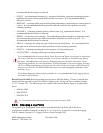
5. The SSM Alarms and Events window (Section 5.2.2.3: on page 151)
A standard configuration for logging services is usually set by the administrator during the HPSS system
configuration. Specialized configurations can be set up and used to temporarily (or permanently) provide
more or less logging for site-specific or shift-specific operational situations. Increasing the level of
logging may slow down overall system operation due to the overhead of extra messages, and decreasing
the amount of logging may eliminate certain log messages that could prove useful in a postmortem
analysis of problem situations. The logging configuration can be tailored as needed to satisfy site or shift
requirements.
Each SSM graphical user session (hpssgui) and command line session (hpssadm) can write a session log
file of the SSM error and informational messages issued during the session. These are not the same as
the alarm, event, and other HPSS log messages described above and are not described in this chapter.
See the '-S' option in the hpssgui and hpssadm man pages for details.
9.2. Log Policies
For any HPSS server or utility which uses the HPSS logging facility, a log policy can be configured to
specify which log message types will be sent to the HPSS logs and which message types will be sent to
SSM for display. Log policies are configured by Server Name, which is displayed on each HPSS
Server's Server Configuration window.
If no log policy is configured for a server, the server will use the Default Log Policy. If no
default is defined, only Alarm and Event message types will be logged.
After changing any log policy information, including the Default Log Policy, the appropriate Log Clients
must be reinitialized to make the changes effective. The Log Clients associated with a particular policy
are the ones which execute on the same hosts as the servers to which the policy applies. For example, if
you modified only policies for servers which execute on host A, then only the Log Client which runs on
host A needs to be reinitialized. The Mover log policy is handled differently. If the Mover log policy is
modified, the Mover itself must be reinitialized in order for the policy changes to take effect.
9.2.1. Creating a Log Policy
A log policy can be created for any unique name which is typed into the Descriptive Name field on the
Logging Policy window, regardless of whether or not the name refers to any actual server or utility.
A new log policy can be created and managed using the Log Policy window or via the Log Policy tab of
of an HPSS Server's Server Configuration window (Section 5.1.1.1: Log Policy on page 95). This Log
Policy window can be accessed from the Logging Policies window (Section 9.2.2: Logging Policies
Window on page 296). From this window, a log policy can be created for any unique name which is
typed into the Descriptive Name field on the Logging Policy window, regardless of whether or not the
name refers to any actual server or utility.
A server's logging policy is determined according to the following precedence rules:
• If a server-specific logging policy is configured for a server, that policy is used for the server.
• If no server-specific logging policy is configured for a server, but a default logging policy is
configured, the default policy will be used for the server.
HPSS Management Guide November 2009
Release 7.3 (Revision 1.0) 295


















